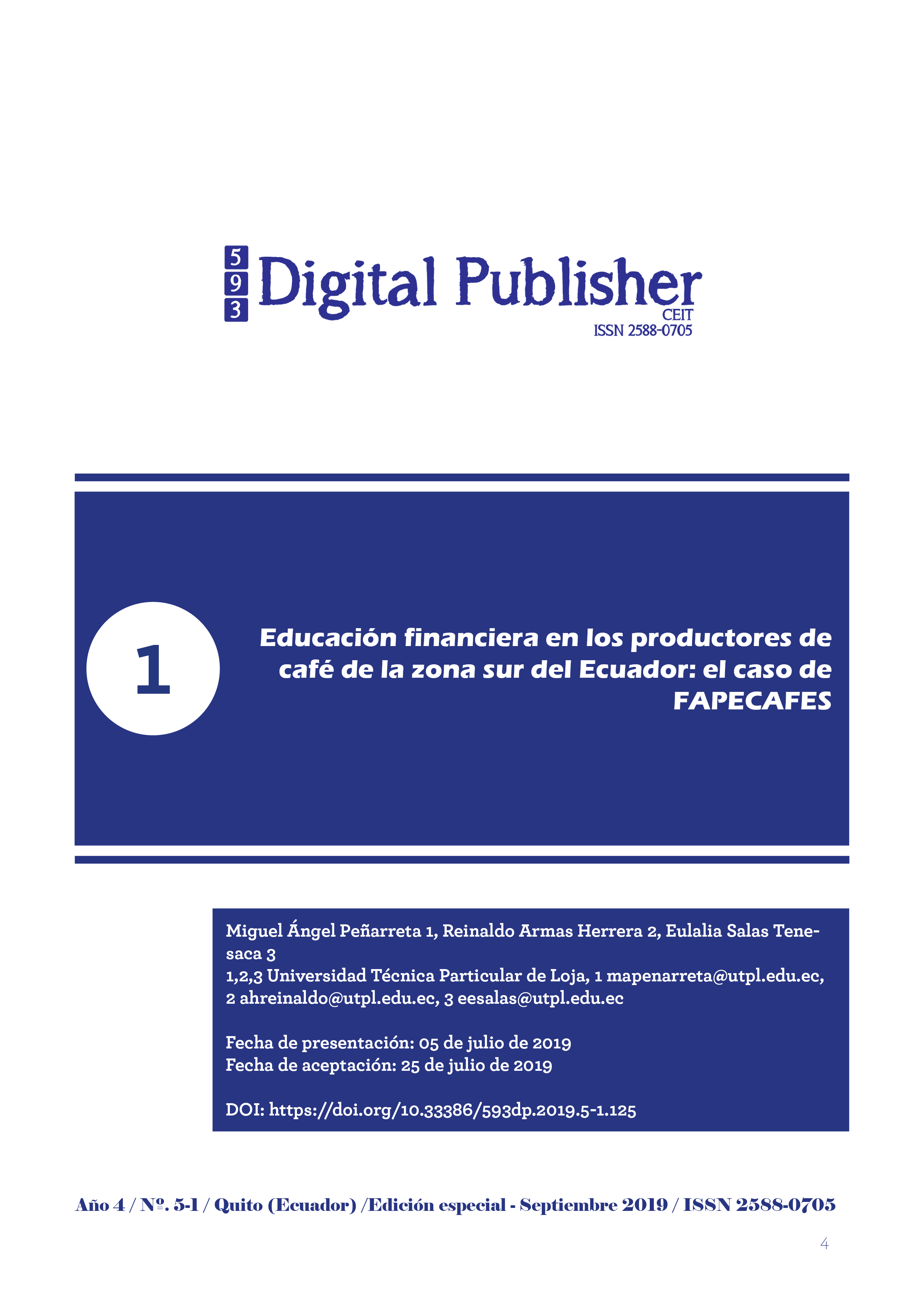Financial education for coffee producers in southern Ecuador: the case of FAPECAFES
Main Article Content
Abstract
This article, based on the triple helix theory, analyzes the level of financial education in popular and solidarity economy organizations based on three dimensions. Through a model survey adapted for Ecuador, information was gathered from 261 members of the coffee growers' association called FAPECAFES, distributed in the provinces of Loja, Zamora Chinchipe and El Oro. The results determined that the population has better results in the dimension financial aptitude (70.31%), followed by the dimension financial behavior (48.5%) and financial knowledge (30.4%). The total score reached by the population is low (49.7%). With respect to gender, women obtained lower scores than men and the population with better results has a fourth level degree. The study also shows that there is a previous financial literacy process in the surveyed population, despite the limited financial training of people living in rural areas of this part of the country. The data will facilitate the design of financial education programs for public-private actors, especially women and managers of popular economy and solidarity organizations in rural areas.
Downloads
Article Details
1. Derechos de autor
Las obras que se publican en 593 Digital Publisher CEIT están sujetas a los siguientes términos:
1.1. 593 Digital Publisher CEIT, conserva los derechos patrimoniales (copyright) de las obras publicadas, favorece y permite la reutilización de las mismas bajo la licencia Licencia Creative Commons 4.0 de Reconocimiento-NoComercial-CompartirIgual 4.0, por lo cual se pueden copiar, usar, difundir, transmitir y exponer públicamente, siempre que:
1.1.a. Se cite la autoría y fuente original de su publicación (revista, editorial, URL).
1.1.b. No se usen para fines comerciales u onerosos.
1.1.c. Se mencione la existencia y especificaciones de esta licencia de uso.
References
Atkinson, A., & Messy, F. (2012). Measuring Financial Literacy (Papers en Finanzas, salud y seguros privados No. 15). OECD Working Papers on Finance, Insurance and Private Pensions. Paris. https://doi.org/10.1787/5k9csfs90fr4-en
Benner, M., & Sandström, U. (2000). Institutionalizing the triple helix: Research funding and norms in the academic system. Research Policy, 29(2), 291–301. https://doi.org/10.1016/S0048-7333(99)00067-0
Bucher- Koenen, T., & Lusardi, A. M. (2011). Financial Literacy and Retirement Planning in Germany. Journal of Pension Economics, 10(4), 565–584. https://doi.org/10.2139/ssrn.2198641
Clark, R., Lusardi, A., & Mitchell, O. S. (2015). Financial Knowledge and 401 ( k ) Investment Performance : A Case Study Financial Knowledge and 401 ( k ) Investment Performance : A Case Study. Journal of Pension Economics, 401, 1–35.
Grifoni, A; Messy, F. (2013). Current status of national strategies for financial education. Paris.
Gutter, M., & Copur, Z. (2011). Financial Behaviors and Financial Well-Being of College Students : Evidence from a National Survey Financial Behaviors and Financial Well-Being of College Students : Evidence from a National Survey. Journal of Family and Economic, (July 2014), 17. https://doi.org/10.1007/s10834-011-9255-2
Hannon, G., Covington, M., Frank-miller, E., & Grinstein-weiss, M. (2017). Employee Financial Wellness Programs : and Directions for Future Research (No. 17–23) (Vol. 17–23). Washington.
Instituciones Financieras Ecuador. (2017). Programa de Educación Financiera - Finanzas Personales. Retrieved May 4, 2017, from http://tusfinanzas.ec/
Jappelli, T., & Padula, M. (2013). Investment in financial literacy and saving decisions. Journal of Banking and Finance, 37(8), 2779–2792. https://doi.org/10.1016/j.jbankfin.2013.03.019
Kiliyanni, A. L., & Sivaraman, S. (2016). International Review of Economics Education The perception-reality gap in fi nancial literacy : Evidence from the most literate state in India. Biochemical Pharmacology, 23, 47–64. https://doi.org/10.1016/j.iree.2016.07.001
Klapper, L., Lusardi, A., & Van Oudheusden, P. (2015). Financial Literacy Around the World: Insights from The Standard & Poor’s Ratings Services Global Financial Literacy Survey. Standard & Poor’s Ratings Services Global FinLit Survey, 1–28. https://doi.org/10.1017/S1474747211000448
Leydesdorff, L., & Etkowitz, H. (2000). A Triple Helix of University-Industry-Govemment Relations. Universities and the Global Knowledge Economy: A Triple Helix of University-Lndustry-Government Relations, 5(4), 155–162.
Lusardi, A., & Mitchell, O. S. (2014a). The economic importance of financial literacy: Theory and evidence. Journal of Economic Literature, 52(April), 138.
Lusardi, A., & Mitchell, O. S. (2014b). The economic importance of financial literacy. Journal of Economic Literature, 52(1), 5–44. https://doi.org/10.1257/jel.52.1.5
Mejia, D., Pallotta, A., & EgÚsquiza, E. (2015). Encuesta de medición de capacidades financieras en los países andinos: Ecuador (CAF Corpor). Perú.
Miller, M., Reichelstein, J., Salas, C., & Bilal, Z. (2014). Can You Help Someone Become Financially Capable ? A Meta-Analysis of the Literature. Washington: World bank. Retrieved from http://econ.worldbank.org
Mitchell, O. S., & Lusardi, A. (2015). Financial Literacy and Economic Outcomes: Evidence and Policy Implications. The Journal of Retirement, 3(1), 107–114. https://doi.org/10.3905/jor.2015.3.1.107
Okubo, Y., & Sjoberg, C. (2000). The changing pattern of industrial scientific research collaboration in Sweden. Research Policy, 108(7), 18. https://doi.org/10.1149/1.2428171
Peñarreta, M., Tinizaray, G., & Herrera, A. (2019). Educación financiera y factores determinantes : Evidencias desde. Revista Espacios, 40, 1–14. Retrieved from http://www.revistaespacios.com/a19v40n07/a19v40n07p11.pdf
Rodriguez, M., & Rojas, L. (2014). Vinculación universidad empresa estado, algunas experiencias en américa y otros países de Europa y Asia. Caracas. Retrieved from https://www.redalyc.org/pdf/782/78232555006.pdf
Rooij, M. Van, Lusardi, A., & Alessie, R. (2011). Financial literacy and stock market participation. Journal of Financial Economics, 101(2), 449–472. https://doi.org/10.1016/j.jfineco.2011.03.006
Shen, C. H., Lin, S. J., Tang, D. P., & Hsiao, Y. J. (2016). The relationship between financial disputes and financial literacy. Pacific Basin Finance Journal, 36(November 2009), 46–65. https://doi.org/10.1016/j.pacfin.2015.11.002
Trias Pintó, C., Castelló Muñoz, E., Staffan, N., & Smyth, M. (2013). Educación financiera para todos. Estrategias y buenas prácticas de educación financiera en la Unión Europea. Comité Económico y Social Europeo, (978-92-830-1982–4), 24–48.
Xu, L., & Zia, B. (2012). Financial Literacy around the World An Overview of the Evidence with Practical Suggestions for the Way Forward. Washington: The World Bank Development Research Group. Retrieved from http://econ.worldbank.org

